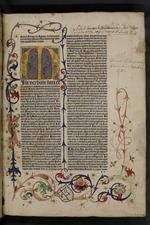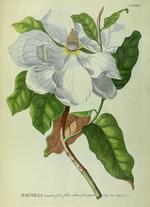Three men who were to play a significant role in the library's creation included the cathedral's first dean, Frederick William Dwelly (1881-1957), Sir Frederick Radcliffe (1861-1952), sometime chair of the cathedral's building committee, and Francis Carolus Eeles (1876-1954), liturgical historian and secretary to the Central Council for the Care of Churches. Radcliffe, after whom the library was named, was its chief donor, and at Dwelly's suggestion he engaged as his primary advisors first Eeles and later Stanley Morison (1888-1967), a typographical historian and the man responsible for the design of the now ubiquitous 'Times New Roman' typeface. By 1933 Eeles had already systematically built up a small collection of around 150 books with a strong liturgical focus but the engagement of Radcliffe in the library project allowed for more expensive purchases. At the sale by Sotheby's of London of the library of John Meade Falkner (1858-1932), former chairman of the Armstrong armaments manufacturing company, Eeles purchased on Radcliffe's behalf five manuscripts and eight early printed books, including the Shepton Beauchamp Missal (MS.29).
The purchased manuscripts indicate a concern to acquire texts from the pre-Reformation era. At that time the Roman rite was celebrated in England according to a number of local traditions called 'Uses'. Chief among these were the Uses of Salisbury – or 'Sarum' – and of York. Hence Eeles acquired for Radcliffe two Sarum Missals (Ker, 162-213, nos. 29 and 40, sale lots 294 and 229 respectively), a Sarum Manual of the fourteenth century (Ker no. 20; lot 264), and a Sarum Processional dated between the second half of the fourteenth century and the fifteenth century (Ker no. 35; lot 397). There is also, from beyond England, a Cologne Manual (Ker no. 14; lot 262). The printed texts include a cluster of office books comprising a two volume Sarum Breviary of 1556-7 (lot 121), a Cistercian Breviary of 1542 (lot 126), and a Sarum Book of Hours of 1526 (lot 228). Alongside them Eeles also bought four printed Missals: Sarum Missals of 1514 (lot 330) and 1527 (lot 338), a 1533 York Missal (lot 313) and a Cistercian Missal of 1560 (lot 339). The sale was completed with a Roman Catholic Primer of 1669 (lot 395).
The library was developed through three principal means: the purchase or donation of libraries; Dwelly's own move to a more systematic approach to purchasing modern texts; and Radcliffe's own individual purchases of manuscripts and early printed liturgical books. In terms of the acquisition of libraries, some were the small, personal collections of deceased clergyman, the purchase of which was negotiated by Eeles with widows or heirs throughout the 1930s. In addition to these minor purchases, three substantial acquisitions were made, that brought a number of significant items into the library.
The first was the collection of Hon. Kenneth Francis Gibbs (1856-1935), late archdeacon of St Albans. This was a principally biblical collection that brought into the library a number of sixteenth and seventeenth century bibles and early commentaries. The second was the donation of liturgical manuscripts and early printed books collected by the chemical industrialist Sir Max Muspratt (1872-1934). Through the gift of this collection to the cathedral by Muspratt's widow, the library acquired a number of fifteenth century European manuscript books of hours (Ker nos. 8, 9 and 17) and some manuscript copies of non-liturgical patristic and medieval works (Ker nos. 12, 21, 28 and 34). The Muspratt donation also included a mid-thirteenth century Latin bible (Ker no. 13), and a large number of early printed books chiefly of liturgical and scholastic interest.
The largest and most significant acquisition of a single library was that of Christopher Wordsworth (1848-1938). Wordsworth was the last significant scion of a dynasty of academics and high church clergyman descended from a previous Christopher Wordsworth (1774-1846), Master of Trinity College Cambridge and the youngest brother of the poet William Wordsworth. Two sons of the first Christopher became Anglican bishops: Charles (1806-1892), bishop of St Andrews, Dunkeld and Dunblane and Christopher (1807-1885), bishop of Lincoln.
Of the two sons of this second Christopher, the elder, John (1843-1911), became bishop of Salisbury, while the younger was the Christopher whose library Radcliffe purchased. This third Christopher was himself an ordained priest of the Church of England, and his ecclesiastical appointments closely tracked the episcopal careers of his father and brother: he served as chancellor of Lincoln Cathedral and later was a canon of Salisbury Cathedral, where he held a number of posts including that of librarian and chancellor. From 1895 until his death he was also warden of St Nicholas' Hospice in Salisbury (History of Wiltshire 1956, 343-356) and it was in the Master's house there that he housed not only his own collection but also family books and manuscripts that had belonged to or were written by his brother, father, uncle and grandfather.



